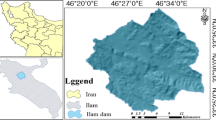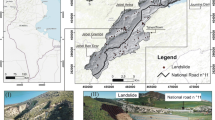Abstract
Landslides and their assessments are of great importance since they damage properties, infrastructures, environment, lives and so on. Particularly, landslide inventory, susceptibility, and hazard or risk mapping have become important issues in the last few decades. Such maps provide useful information and can be produced by qualitative or quantitative methods. The work presented in this paper aimed to assess landslide susceptibility in a selected area, covering 570.625 km2 in the Western Black Sea region of Turkey, by two quantitative methods. For this purpose, in the first stage, a detailed landslide inventory map was prepared by extensive field studies. A total of 96 landslides were mapped during these studies. To perform landslide susceptibility analyses, six input parameters such as topographical elevation, lithology, land use, slope, aspect and distance to streams were considered. Two quantitative methods, logistic regression and fuzzy approach, were used to assess landslide susceptibility in the selected area. For the fuzzy approach, the fuzzy and, or, algebraic product, algebraic sum and gamma operators were considered. At the final stage, 18 landslide susceptibility maps were produced by the logistic regression and fuzzy operators in a GIS (Geographic Information System) environment. Two performance indicators such as ROC (relative operating characteristics) and cosine amplitude method (r ij ) were used to validate the final susceptibility maps. Based on the analyses, the landslide susceptibility map produced by the fuzzy gamma operator with a level of 0.975 showed the best performance. In addition, the maps produced by the logistic regression, fuzzy algebraic product and the higher levels of gamma operators showed more satisfactory results, while the fuzzy and, or, algebraic sum maps were not sufficient to provide reliable outputs.









Similar content being viewed by others
References
Aleotti P, Chowdhury R (1999) Landslide hazard assessment: summary review and new perspectives. Bull Eng Geol Environ 58:21–44
Ayalew L, Yamagishi H (2005) The application of GIS-based logistic regression for landslide susceptibility mapping in the Kakuda-Yahiko Mountains, Central Japan. Geomorphology 65:15–31
Bai SB, Wang J, Lü GN, Zhou PG, Hou SS, Xu SN (2010) GIS-based logistic regression for landslide susceptibility mapping of the Zhongxian segment in the Three Gorges area, China. Geomorphology 115:23–31
Berkan RC, Trubatch SL (1997) Fuzzy systems design principles, building fuzzy if-then rule bases. IEEE Press, USA
Bonham-Carter GF (1994) Geographic information systems for geoscientists, Modeling with GIS. Pergamon, England
Can T, Nefeslioglu AH, Gokceoglu C, Sonmez H, Duman TY (2005) Susceptibility assessments of shallow earthflows triggered by heavy rainfall at three catchments by logistic regression analyses. Geomorphology 72(1–4):250–271
Caniani D, Pascale S, Sdao F, Sole A (2008) Neural networks and landslide susceptibility: a case study of the urban area of Potenza. Nat Hazards 45:55–72
Chacon J, Irigaray C, Fernandez T, El Hamdouni R (2006) Engineering geology maps: landslides and geographical information systems. Bull Eng Geol Environ 65:341–411
Chauhan S, Sharma M, Arora MK, Gupta NK (2010) Landslide susceptibility zonation through ratings derived from artificial neural network. Int J Appl Earth Observ Geoinf 12:340–350
Choi J, Oh HJ, Won JS, Lee S (2010) Validation of an artificial neural network model for landslide susceptibility mapping. Environ Earth Sci 60:473–483
Clark WA, Hosking PL (1986) Statistical methods for geographers. Wiley, USA
Cruden DM, Varnes DJ (1996) Landslide types and processes. In: Turner AK, Schuster RL (eds) Landslides: investigation and mitigation. Tranportation research board, Special report 247. National Academy Press, Washington, pp 36–75
Dai FC, Lee CF, Zhang XH (2001) GIS-based geo-environmental evaluation for urban land-use planning: a case study. Eng Geol 61:257–271
Duman TY, Can T, Gokceoglu C, Nefeslioglu HA, Sonmez H (2006) Application of logistic regression for landslide susceptibility zoning of Cekmece Area, Istanbul, Turkey. Environ Geol 51:241–256
Eastman JR (2009) Idrisi Taiga, guide to GIS and image processing, user’s guide (Ver. 15). Clark University Press, USA, 328 pp
EM-DAT (Emergency events database) (2010) http://www.emdat.be, verified in 21.02.2010
Ercanoglu M (2005) Landslide susceptibility assessment of SE Bartin (West Black Sea region, Turkey) by artificial neural networks. Nat Hazards Earth Syst Sci 5:979–992
Ercanoglu M, Gokceoglu C (2002) Assessment of landslide susceptibility for a landslide-prone area (north of Yenice, NW Turkey) by fuzzy approach. Environ Geol 41:720–730
Ercanoglu M, Gokceoglu C (2004) Use of fuzzy relations to produce landslide susceptibility map of a landslide prone area (West Black Sea Region, Turkey). Eng Geol 75:229–250
Ercanoglu M, Gokceoglu C, Van Asch TWJ (2004) Landslide susceptibility zoning of North of Yenice (NW Turkey) by mutivariate statistical techniques. Nat Hazards 32:1–23
Ermini L, Catani F, Casagli N (2005) Artificial neural networks applied to landslide susceptibility assessment. Geomorphology 66:327–343
Falaschi F, Giacomelli F, Federici PR, Puccinelli A, Avanzi GD, Pochini A, Ribolini A (2009) Logistic regression versus artificial neural networks: landslide susceptibility evaluation in a sample area of the Serchio River valley, Italy. Nat Hazards 50:551–569
Fell R, Corominas J, Bonnard C, Cascini L, Leroi E, Savage WZ (2008) Guidelines for landslide susceptibility, hazard and risk zoning for land-use planning. Eng Geol 102:99–111
Gokceoglu C, Sezer E (2009) A statistical assessment on international landslide literature (1945–2008). Landslides 6:345–351
Gomez H, Kavzoglu T (2005) Assessment of shallow landslide susceptibility using artificial neural network in Jabonosa River basin, Venezuela. Eng Geol 78:11–27
Gorsevski PV, Jankowski P (2010) An optimized solution of multi-criteria evaluation analysis of landslide susceptibility using fuzzy sets and Kalman filter. Comp Geosci 36:1005–1020
Guzzetti F, Carrara A, Cardinali M, Reichenbach P (1999) Landslide hazard evaluation: a review of current techniques and their application in a multi-scale study, Central Italy. Geomorphology 31:181–216
Guzzetti F, Cardinali M, Reichenbach P, Carrara A (2000) Comparing landslides maps: a case study in the Upper Tiber basin, Central Italy. Environ Manag 25(3):247–263
Guzzetti F, Reichenbach P, Ardizzone F, Cardinali M, Galli M (2006) Estimating the quality of landslide susceptibility models. Geomorphology 81:166–184
Hutchinson JN (1995) Landslide hazard assessment. In: Proceedings of the VIth International Symposium on landslides, vol 1, Christchurch, pp 1805–1842
Kanungo DP, Arora MK, Sarkar S, Gupta RP (2006) A comparative study of conventional, ANN black box, fuzzy and combined neural and fuzzy weighting procedures for landslide susceptibility zonation in Darjeeling Himalayas. Eng Geol 85:347–366
Kanungo DP, Arora MK, Sarkar S, Gupta RP (2009) A fuzzy set based approach for integration of thematic maps for landslide susceptibility zonation. Georisk 3(1):30–43
Kawabata D, Bandibas J (2009) Landslide susceptibility mapping using geological data, a DEM from ASTER images and an artificial neural network (ANN). Geomorphology 113:97–109
Kirschbaum DB, Adler R, Hong Y, Lerner-Lam A (2009) Evaluation of a preliminary satellite-based landslide hazard algorithm using global landslide inventories. Nat Hazards Earth Syst Sci 9:673–686
Lee S (2007) Application and verification of fuzzy algebraic operators to landslide susceptibility mapping. Environ Geol 52:615–623
Lee S, Sambath T (2006) Landslide susceptibility mapping in the Damrei Romel area, Cambodia using frequency ratio and logistic regression models. Environ Geol 50:847–855
Lee S, Talib JA (2005) Probabilistic landslide susceptibility and factor effect analysis. Environ Geol 47:982–990
Lee S, Ryu JH, Kim LS (2007) Landslide susceptibility analysis and its verification using likelihood ratio, logistic regression, and artificial neural network models: case study of Youngin, Korea. Landslides 4:327–338
Mancini F, Ceppi C, Ritrovato G (2010) GIS and statistical analysis for landslide susceptibility mapping in the Daunia area, Italy. Nat Hazards Earth Syst Sci 10:1851–1864
Menard S (2002) Applied logistic regression analysis, 2nd edn. SAGE, USA, 111 pp
MTA (Mineral Research and Exploration) (2004) 1/100000 scale of Turkey Geological Map (Kastamonu quadrangle). (in Turkish)
Nandi A, Shakoor A (2009) A GIS-based landslide susceptibility evaluation using bivariate and multivariate statistical analyses. Eng Geol 110:11–20
Nefeslioglu HA, Gokceoglu C, Sonmez H (2008) An assessment on the use of logistic regression and artificial neural networks with different sampling strategies for the preparation of landslide susceptibility maps. Eng Geol 97:171–191
Ott RL, Longnecker M (2001) An introduction to statistical methods and data analysis, 5th edn. Duxbury Press, USA
Poudyal CP, Chang C, Oh HJ, Lee S (2010) Landslide susceptibility maps comparing frequency ratio and artificial neural networks: a case study from the Nepal Himalaya. Environ Earth Sci 61:1049–1064
Pradhan B (2010) Remote sensing and GIS-based landslide hazard analysis and cross-validation using multivariate logistic regression model on three test areas in Malaysia. Adv Space Res 45:1244–1256
Pradhan B, Lee S (2010) Landslide susceptibility assessment and factor effect analysis: back propagation artificial neural networks and their comparison with frequency ratio and bivariate logistic regression modelling. Environ Model Softw 25:747–759
Pradhan B, Lee S, Buchroithner MF (2009) Use of geospatial data and fuzzy algebraic operators to landslide-hazard mapping. Appl Geomat 1:3–15
Pradhan B, Lee S, Buchroithner MF (2010) A GIS-based back-propagation neural network model and its cross-application and validation for landslide susceptibility analyses. Comput Environ Urban Syst 34:216–235
Regmi NR, Giardino JR, Vitek JD (2010) Modeling susceptibility to landslides using the weight of evidence approach: Western Colorado, USA. Geomorphology 115:172–187
Ross TJ (1995) Fuzzy logic with engineering applications. Mc-Graw-Hill, USA
Rossi M, Guzzetti F, Reichenbach P, Mondini AC, Peruccacci S (2010) Optimal landslide susceptibility zonation based on multiple forecasts. Geomorphology 114:129–142
Strahler AN (1957) Quantitative analysis of watershed geomorphology. Trans Am Geophys Union 38:913–920
Süzen ML, Doyuran V (2004a) A comparison of the GIS based landslide susceptibility assessment methods: multivariate versus bivariate. Environ Geol 45:665–679
Süzen ML, Doyuran V (2004b) Data driven bivariate landslide susceptibility assessment using geographical information systems: a method and application to Asarsuyu catchment, Turkey. Eng Geol 71:303–321
Tangestani MH (2009) A comparative study of Dempster–Shafer and fuzzy models for landslide susceptibility mapping using a GIS: an experience from Zagros Mountains, SW Iran. J Asian Earth Sci 35:66–73
Ulusay R, Aydan Ö, Kılıç R (2007) Geotechnical assessment of the 2005 Kuzulu landslide (Turkey). Eng Geol 89:112–128
Vahidnia MA, Alesheikh AA, Alimohammadi A, Hosseinali F (2010) A GIS-based neuro-fuzzy procedure for integrating knowledge and data in landslide susceptibility mapping. Comp Geosci 36:1101–1114
Van Den Eeckhaut M, Vanwalleghem T, Poesen J, Govers G, Verstraeten G, Vandekerckhove L (2006) Prediction of landslide susceptibility using rare events logistic regression: a case-study in the Flemish Ardennes (Belgium). Geomorphology 76:392–410
Van Westen CJ, Van Asch TWJ, Soeters R (2006) Landslide hazard and risk zonation—why is it still so difficult? Bull Eng Geol Environ 65:167–184
Van Westen CJ, Castellanos E, Kuriakose SL (2008) Spatial data for landslide susceptibility, hazard, and vulnerability assessment: an overview. Eng Geol 102:112–131
Wang W, Xie C, Du X (2009) Landslides susceptibility mapping in Guizhou province based on fuzzy theory. Min Sci Technol 19:399–404
Yesilnacar E, Topal T (2005) Landslide susceptibility mapping: a comparison of logistic regression and neural networks methods in a medium scale study, Hendek region (Turkey). Eng Geol 79:251–266
Yılmaz I (2009) Landslide susceptibility mapping using frequency ratio, logistic regression, artificial neural networks and their comparison: a case study from Kat landslides (Tokat-Turkey). Comp Geosci 35(6):1125–1138
Yılmaz I (2010) Comparison of landslide susceptibility mapping methodologies for Koyulhisar, Turkey: conditional probability, logistic regression, artificial neural networks, and support vector machine. Environ Earth Sci. doi:10.1007/s12665-009-0394-9
Zadeh LA (1965) The concept of a linguistic variable and its application to approximate reasoning. Inf Sci 8:199–249
Acknowledgments
This research was supported by the Scientific and Technical Research Council of Turkey (TUBITAK) (Project No. 108Y034). The authors would like to thank Prof. Gunter Doerhofer, Prof. Olaf Kolditz and one anonymous reviewer for their constructive and valuable comments, which increased the quality of the paper.
Author information
Authors and Affiliations
Corresponding author
Rights and permissions
About this article
Cite this article
Ercanoglu, M., Temiz, F.A. Application of logistic regression and fuzzy operators to landslide susceptibility assessment in Azdavay (Kastamonu, Turkey). Environ Earth Sci 64, 949–964 (2011). https://doi.org/10.1007/s12665-011-0912-4
Received:
Accepted:
Published:
Issue Date:
DOI: https://doi.org/10.1007/s12665-011-0912-4




